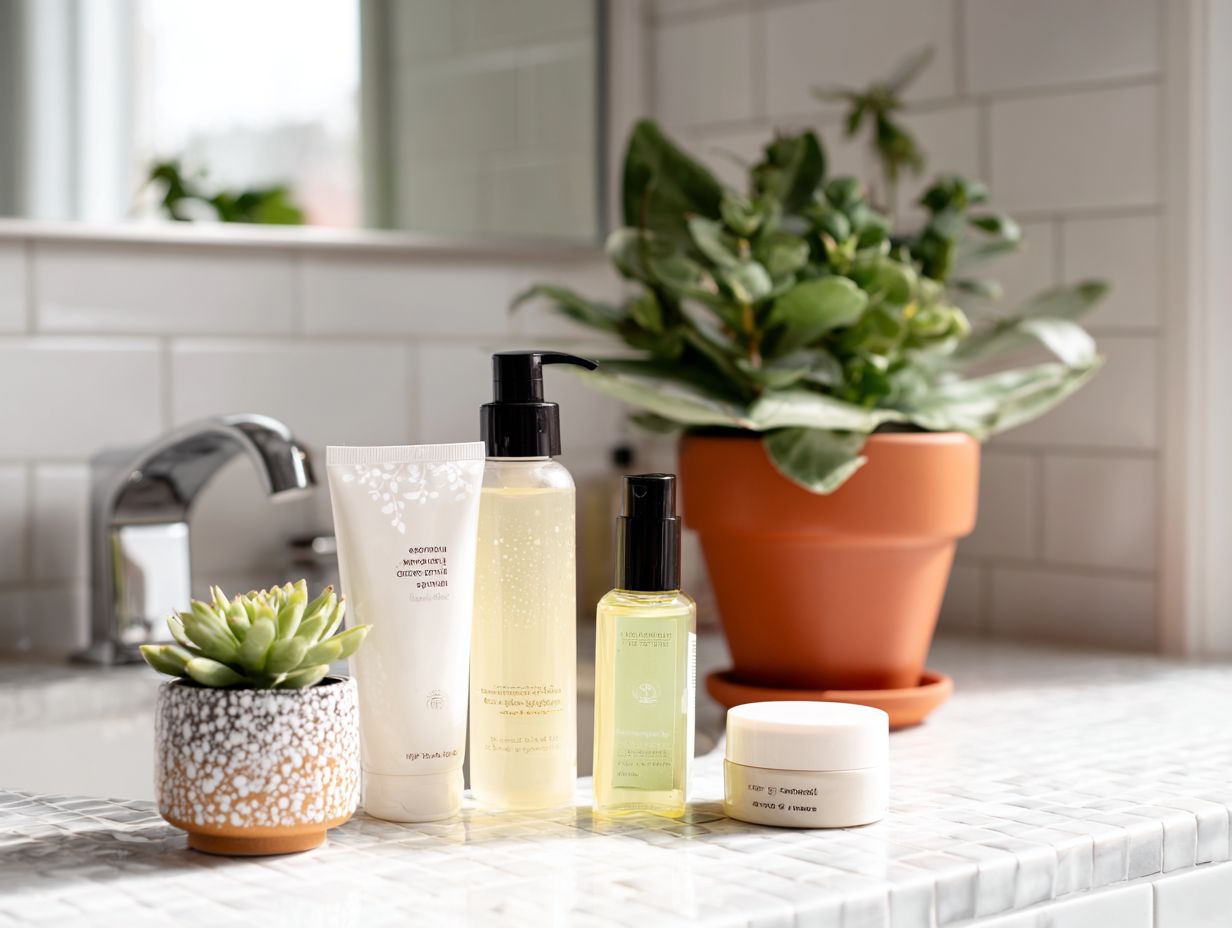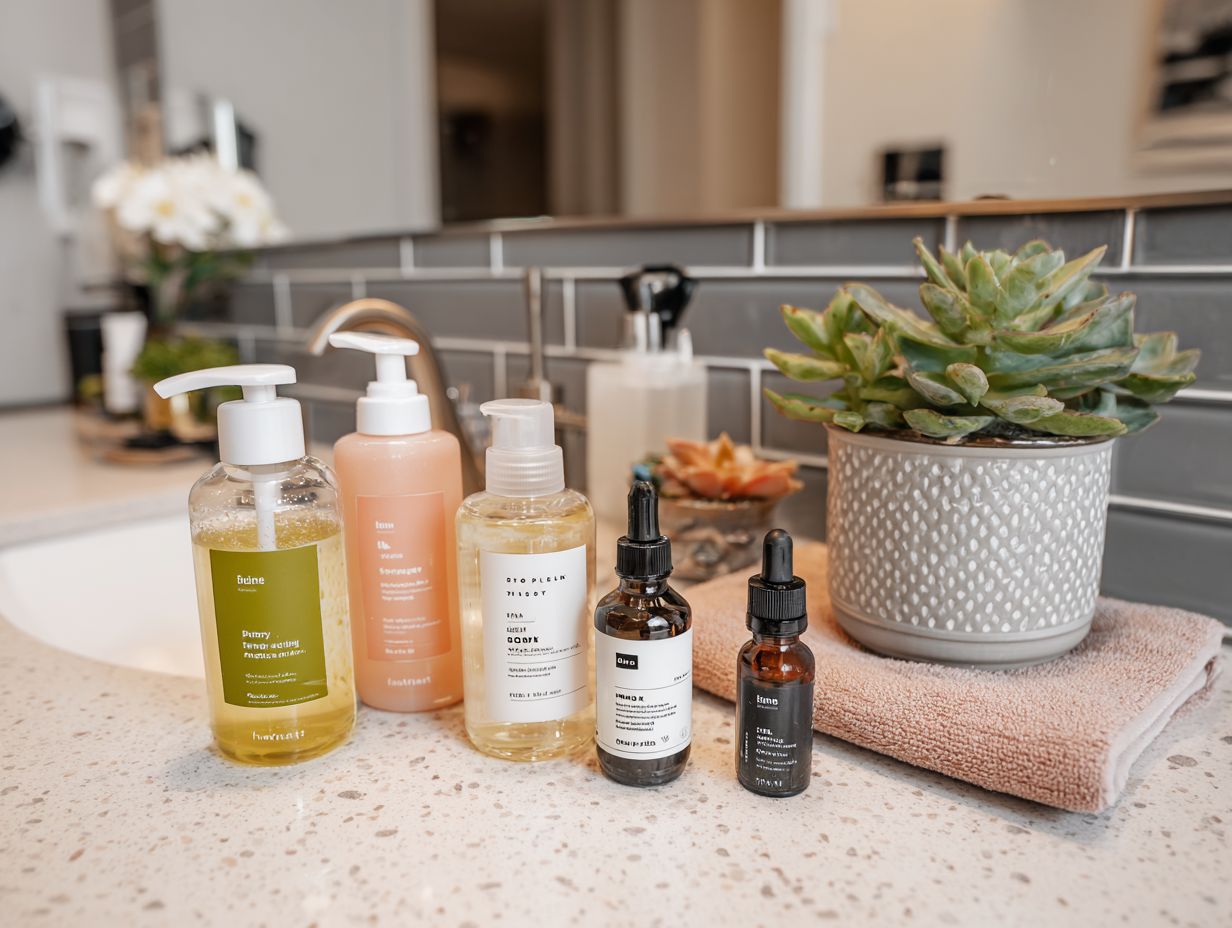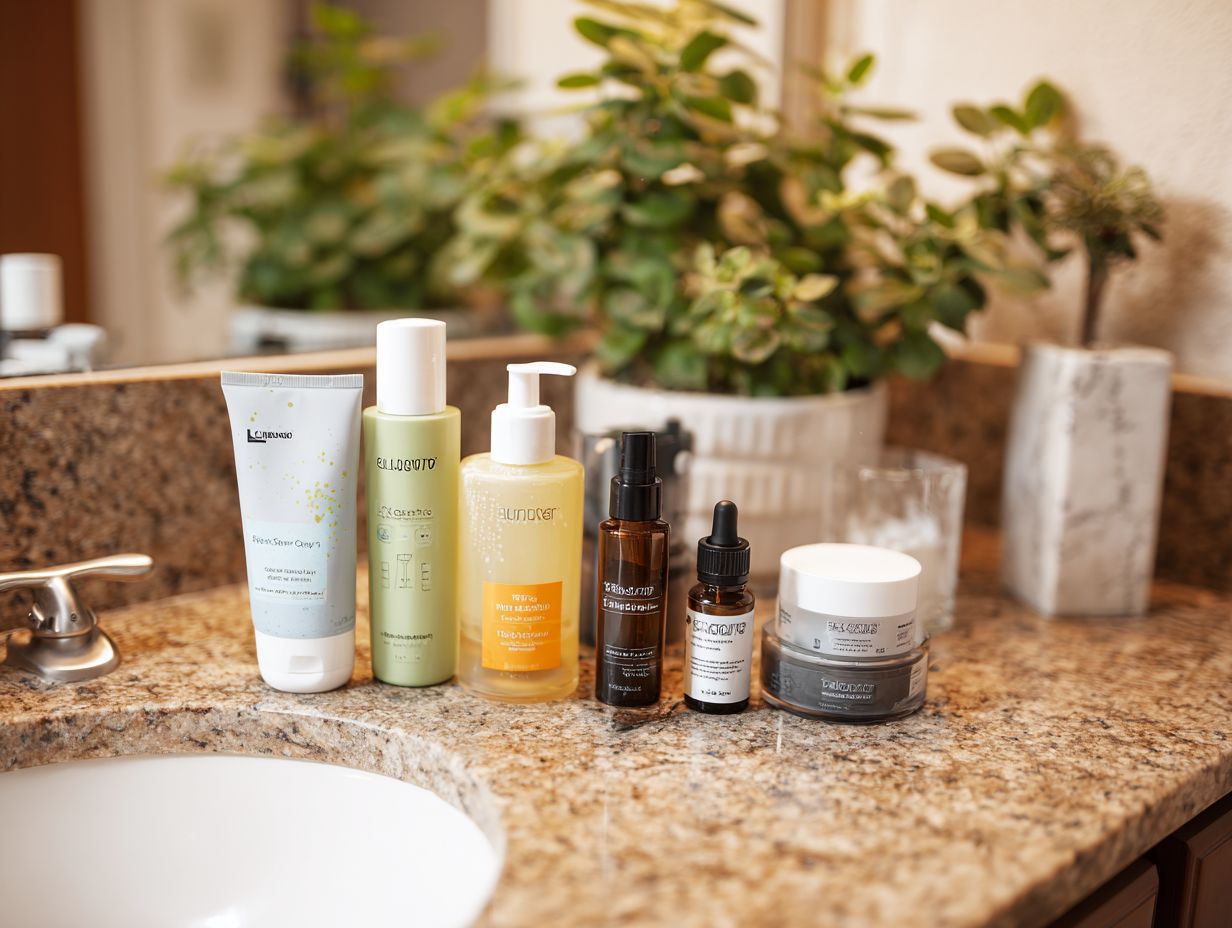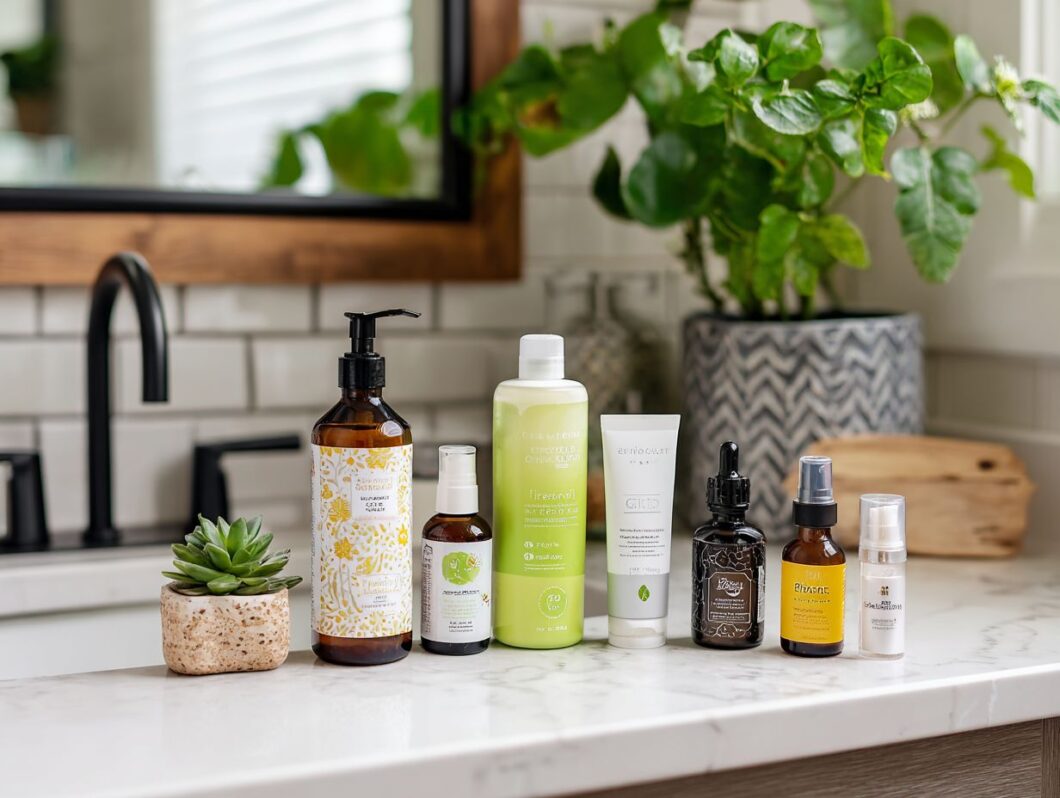Struggling with oily skin and persistent acne breakouts? Crafting the best skincare routine is essential to tackle these skin concerns effectively. Using retinol products can also help treat skin concerns. Influenced by experts like Dr. Sandra Lee of SLMD Skincare and treatments like Accutane or Roaccutane, this guide will walk you through the must-have steps, including using an exfoliating cleanser, salicylic acid toner, and more. Discover how to balance your complexion and achieve clearer skin with the right regimen tailored to your needs.
Key Takeaways:
Understanding Oily, Acne-Prone Skin

I understand that oily, acne-prone skin affects approximately 40% of adults and can lead to considerable skin concerns if not managed effectively.
Causes of Oily Skin
Oily skin is a result of overactive sebaceous glands, often influenced by genetics, hormonal changes, or environmental factors.
Several common elements can exacerbate oily skin. For instance, hormonal fluctuations during puberty and menstruation have a considerable impact on oil production; research indicates that approximately 50% of teenagers experience oily skin at some point in their lives.
Additionally, living in humid climates can lead to increased oiliness, as the moisture in the air stimulates the sebaceous glands. Genetic predisposition also plays a significant role; individuals with a family history of oily skin may be more prone to experiencing it themselves. This correlation is supported by studies showing higher prevalence rates in specific demographics.
Common Acne Triggers
Several factors can contribute to acne breakouts, including diet, stress, and specific skincare products. To minimize acne, I recommend considering the following actionable strategies:
- Reducing high-glycemic-index foods such as white bread and sugary snacks can be beneficial. Including honey and oatmeal in your diet can also help improve skin texture. Replacing them with whole grains and vegetables may lead to clearer skin.
- Managing stress is equally important; engaging in activities like yoga or meditation can help lower cortisol levels, which are linked to breakouts.
- It is essential to be cautious with cosmetics and opt for non-comedogenic products that will not clog pores.
For example, incorporating a gentle salicylic acid cleanser into a skincare routine may enhance the skin’s appearance over time. One individual noted that eliminating dairy significantly reduced their breakouts, highlighting the influence of diet in acne management.
Essential Steps in a Skincare Routine
I understand that having a structured skincare routine is essential for effectively managing oily, acne-prone skin.
My routine typically includes key steps such as cleansing, exfoliating, and toning to ensure optimal skin health.
Step 1: Cleansing
Cleansing effectively twice daily is essential for removing excess oil and preventing acne. I begin my morning and evening routines with a gentle yet effective cleanser, such as CeraVe Foaming Facial Cleanser, which contains ceramides to maintain my skin barrier while removing impurities.
For deeper cleansing, I consider incorporating exfoliating cleansers that contain salicylic acid or glycolic acid to help eliminate dead skin cells and unclog pores. Products from brands like CeraVe, Drunk Elephant, and Cetaphil are highly recommended. I always look for products labeled as `oil-free’ to ensure they won’t worsen the oiliness of my skin.
I also tailor my choices based on my skin’s sensitivity, opting for lighter formulations if my skin is reactive and gradually transitioning to more potent options as my skin adjusts.
Step 2: Exfoliating

Incorporating exfoliating agents such as salicylic acid is essential for effectively removing dead skin cells and unclogging pores.
To properly exfoliate oily skin, I recommend integrating a chemical exfoliant into your skincare routine. A highly regarded option is Paula’s Choice Skin Perfecting 2% BHA Liquid Exfoliant, which specifically targets oiliness and blemishes.
I suggest starting with application twice a week at night and gradually increasing to every other night, depending on how well your skin tolerates it. Hydrating skincare products should also be used to prevent dryness. Another effective choice is The Ordinary Lactic Acid 5% + HA, which provides gentle exfoliation while also hydrating the skin.
It is crucial to always follow up with sunscreen during the day, as exfoliation can increase skin sensitivity to sunlight. Hydrating skincare routines, including the use of lightweight moisturizer, help maintain skin health.
Step 3: Toning
I find that toners are an effective way to balance pH levels and eliminate any remaining impurities after cleansing. Using a toner with salicylic acid can effectively reduce oil production. For individuals with oily skin, toners containing salicylic acid and witch hazel prove particularly beneficial. Consider incorporating Paula’s Choice or The Ordinary products for best results. Salicylic acid penetrates the pores to reduce excess oil and prevent breakouts, while witch hazel serves as an astringent, minimizing the appearance of enlarged pores.
To apply toner, I recommend using a cotton pad to gently wipe it over the face following cleansing, with a focus on the oily areas, especially the T-zone.
For optimal results, I suggest considering products such as Neutrogena, Paula’s Choice, and The Ordinary.
- Neutrogena Oil-Free Acne Stress Control Triple-Action Toner
- Thayers Witch Hazel Toner
Both of these options are well-reviewed and effective. Using them daily can help achieve clear, balanced skin.
Choosing the Right Products
Selecting the appropriate skincare products is crucial for effectively managing oily skin and preventing acne breakouts.
I prioritize understanding my skin’s specific needs to choose products that will help maintain a balanced complexion. Incorporating Vitamin C in your skincare routine can also enhance skin health.
Ingredients to Look For
When selecting products, I prioritize ingredients like niacinamide, retinoids, and oil-free moisturizers to enhance skin health.
For oily skin, niacinamide is effective in regulating sebum production while also improving skin texture. I recommend The Ordinary Niacinamide 10% + Zinc 1%, as it helps minimize pores and reduce excess oil.
Additionally, I find that retinoids, such as Differin Gel, are beneficial for promoting cell turnover, which helps prevent clogged pores and acne. Oil-free moisturizers, like Neutrogena Hydro Boost, offer hydration without clogging pores, thus maintaining a healthy balance.
Incorporating these ingredients into my skincare routine can significantly reduce shine and improve overall skin clarity, resulting in a healthier appearance.
Ingredients to Avoid
I make it a point to avoid products containing heavy oils, alcohols, and fragrances, as these can aggravate oily skin and potentially lead to more breakouts. Retinoids and benzoyl peroxide are effective alternatives that help manage acne. I also steer clear of comedogenic ingredients such as cocoa butter and lanolin, which have a tendency to clog pores, as well as sodium lauryl sulfate, which is known for stripping the skin of its natural oils and causing irritation.
Instead, I opt for lightweight, non-comedogenic products that effectively address my skin concerns. Some of my preferred options include:
- Hyaluronic acid for hydration
- Salicylic acid for exfoliation
- Tea tree oil for its antibacterial properties
I find that brands like Neutrogena and The Ordinary provide affordable and effective alternatives that help maintain skin balance without exacerbating acne.
Additional Tips for Managing Oily Skin

I have found that implementing lifestyle changes can significantly enhance my ability to manage oily skin and prevent acne breakouts.
Diet and Lifestyle Changes
Incorporating a balanced diet and regular exercise has proven to be effective in reducing oil production and enhancing skin health. I focus on including foods rich in Omega-3 fatty acids, such as salmon, flaxseeds, and walnuts, as these are beneficial in regulating oil production. Incorporating jojoba oil in your routine can also help balance oil production.
To manage sugar intake, I often swap sugary snacks for healthier alternatives like berries or nuts. Engaging in regular physical activity, whether it be brisk walking or cycling for at least 30 minutes a day, significantly improves circulation and nourishes my skin cells. Using skincare products from brands like Youth to the People can further enhance skin texture.
Staying hydrated is equally crucial; I aim to drink at least 8 glasses of water daily. Together, these strategies contribute to promoting a healthier, more radiant complexion.
When to Consult a Dermatologist
Understanding when to seek assistance from a dermatologist is crucial for preventing long-term skin damage and enhancing treatment outcomes. I consider consulting a dermatologist if I experience persistent acne despite my self-treatment efforts, encounter severe skin irritation that doesn’t improve, or notice any unusual moles or changes in my skin.
Professional treatments, such as Accutane, can be highly effective for severe acne, while chemical peels may address texture and pigmentation concerns. Consulting with a dermatologist affiliated with the American Academy of Dermatology can provide more personalized acne treatments.
If I find that over-the-counter products have not provided results after several months, I recognize that it may be time to seek specialized advice to develop a skincare regimen tailored specifically to my needs.
Frequently Asked Questions
1. What is the best skincare routine for oily, acne-prone skin?
The best skincare routine for oily, acne-prone skin involves using gentle, oil-free cleansers, exfoliating regularly, and using non-comedogenic moisturizers and treatments.
2. Should I use a cleanser specifically made for oily, acne-prone skin?

Yes, using a cleanser formulated for oily, acne-prone skin can help remove excess oil and impurities without stripping the skin of its natural oils. Incorporating a toner with salicylic acid in your skin care routine can further enhance the cleansing process.
3. Is exfoliation important for oily, acne-prone skin?
Exfoliation is crucial for oily, acne-prone skin as it helps remove dead skin cells and unclog pores, preventing breakouts and promoting healthy skin renewal. A skin routine suggested by a dermatologist specializing in acne can include products from brands like Paula’s Choice or The Ordinary.
4. What ingredients should I look for in skincare products for oily, acne-prone skin?
Look for ingredients like salicylic acid, benzoyl peroxide, and glycolic acid, which are known for their acne-fighting and oil-controlling properties. Brands like CeraVe, Drunk Elephant, and Neutrogena offer products suited for these needs. Avoid products with heavy oils, fragrances, and comedogenic ingredients.
5. How often should I moisturize if I have oily, acne-prone skin?
It is important to moisturize daily, even if you have oily, acne-prone skin. Choose a lightweight, non-comedogenic moisturizer and apply it after cleansing (both morning and night) and exfoliating to keep your skin hydrated without clogging pores. Consider options from Youth to the People or SLMD Skincare by Sandra Lee for effective results.
6. Can I skip sunscreen if I have oily, acne-prone skin?
No, sunscreen is still essential for oily, acne-prone skin. Look for oil-free, non-comedogenic options and apply it every day to protect your skin from UV damage and prevent post-acne marks from darkening. The American Academy of Dermatology recommends using sunscreens enriched with Vitamin C for added benefits.


